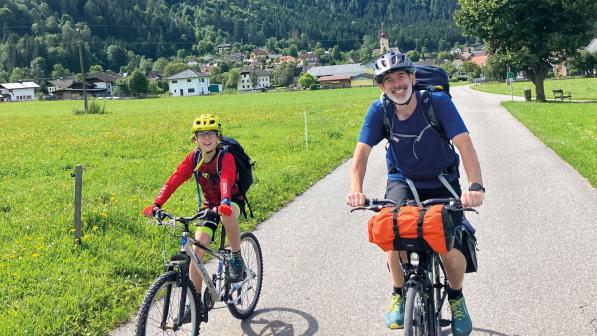Group test: Bikepacking seatpacks

One big advantage of seatpacks over backpacks is that they take weight off your shoulders, relieving stresses and strains, and also leaving you less sweaty.
Compared to panniers, the capacity is lower but they don’t bounce around (or off) as much, and they protrude less. If you and your handlebar will fit through a gap, so will your seatpack-equipped bike.
The most important thing to consider is the clearance between the bag and rear wheel. This is easy to measure if you take your bike to the shop. Smaller frames with big wheels can be a problem, as can full-suspension bikes with more rear wheel travel.
Some seatpacks will fit a bike with a dropper seatpost, but remember to check the space with saddle lowered.
How big a bag? Most have ways of compressing the load and adjusting the volume so err on the larger size. Compressing a bag also improves its stability.
Most seatpacks will move at least a little even when everything is as cinched up tight. It’s whether you notice that movement on the bike that’s crucial.
In the UK, waterproofing of some kind is vital. Some bags are waterproof with welded seams. Some rely on drybags within the sack to keep the weather out.
1. Decathlon Riverside Saddle Bag Harness & Saddle Bag
Price: £54.99 & £19.99
Volume: 0.3L (harness), 15L (saddle bag)
Weight: 590g (harness), 257g (saddle bag)
Available from: Decathlon
Cycling UK members get 10% off selected products from Decathlon.

A slightly different setup here in that you get a large waterproof bag and then a separate harness to fit it to the bike. This means it’s straightforward to take your drybag on and off.
The drybag is robust and can fit between 7 and 15 litres of stuff, plus there is an air valve so compression is very easy. The harness fits to the bike securely, and the whole thing straps together and cinches up to make a solid package.
There’s a bit of extra storage on top of the harness. The straps are all nicely designed to be neat and secure when cinched.
Verdict: Very solid feel, a high-capacity dry-bag and a pretty good price.
2. Passport Bikepacking Saddle Pack Large
Price: £70
Capacity: 9.8L
Weight: 595g
Available from: Passport Cycles

A more traditional water-resistant outer bag that comes with an internal drybag for packing stuff into. You will need this unless it’s bone dry. The pack can be rolled down and compressed to fit your luggage.
There’s a nice addition of two zipped side pockets, which are great for small things that don’t need to be kept dry, and there’s a bungee cord on top for extra storage. Attachment is by two straps on the seatpost and straps under the seat; it’s a pretty stable setup while riding.
Capacity is 9.8L for this Large version. There’s also a 7L Medium bag that’s a fiver less but otherwise the same.
Verdict: A good basic setup at an entry-level price. Don’t forget the drybag!
3. Apidura Expedition Saddlepack 14L
Price: £133
Capacity: 14L
Weight: 350g
Available from: Apidura

This bag is made from Apidura’s three-layer laminate fabric with welded seams, which makes it impressively waterproof even in grim winter conditions.
Attachment straps are robust and rubberised, ensuring a stable riding feel plus a degree of frame protection. It comes in three sizes, although compression of the bag is nice and easy and allows good load security however much you’ve packed. A bungee cord on top provides extra storage.
There’s a handy compatibility guide on the website to ensure the seatpack will fit before purchasing. For those with droppers, Apidura also does a bag with dropper attachment.
Verdict: Not cheap but very well made, with great waterproofing.
4. Ortlieb Seat-pack QR
Price: £168.50
Capacity: 13L
Weight: 625g
Available from: Ortlieb

This is a robust 13L waterproof sack, which clips onto the saddle rails with a sturdy plastic bracket. Once you’ve got the knack, it’s quick to take the bag on and off – check the compatibility of your saddle on the website before you buy. Ortlieb also makes a version without the QR system.
The plastic bracket makes it incredibly stable while riding, plus it comes with an adapter enabling it to be used on dropper as well as standard seatposts. The adapter takes away about 4cm of travel from the dropper.
There is an air valve in the bag, making compression very easy. It’s expensive but should last a long time. The non-QR version is £150 (11L) or £159 (16.5L).
Verdict: Very well designed and made, and typically Ortlieb tough and waterproof.
Overall verdict
Both the Passport and Decathlon bags are good entry-level systems that will suit most people in most circumstances. They’ll cope fine for a wide variety of riding applications.
With the Apidura and Ortlieb bags you are getting higher quality, and their waterproofness is impressive, especially given the relatively low weights. If you can afford the extra, it’s worth splashing out on them. But I’d also be happy touring with either of the two cheaper bags.
All the bags tested had good stability while riding. The Ortlieb – as you’d expect, given the design – was the most stable on really rough stuff. Whether you need that depends on what sort of terrain you plan to ride and if you have a dropper post.
First published in Cycle magazine, April/May 2024 issue. All information correct at time of publishing.
Cycle magazine
Every two months Cycling UK members receive Cycle magazine, filled with interesting and informative articles, news and reviews for all cyclists.
Members can read the magazine in full online; non-members can read selected highlights.



